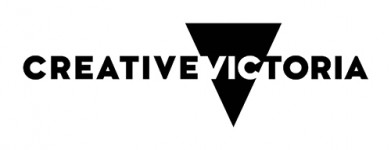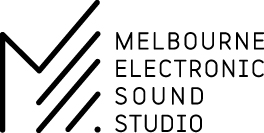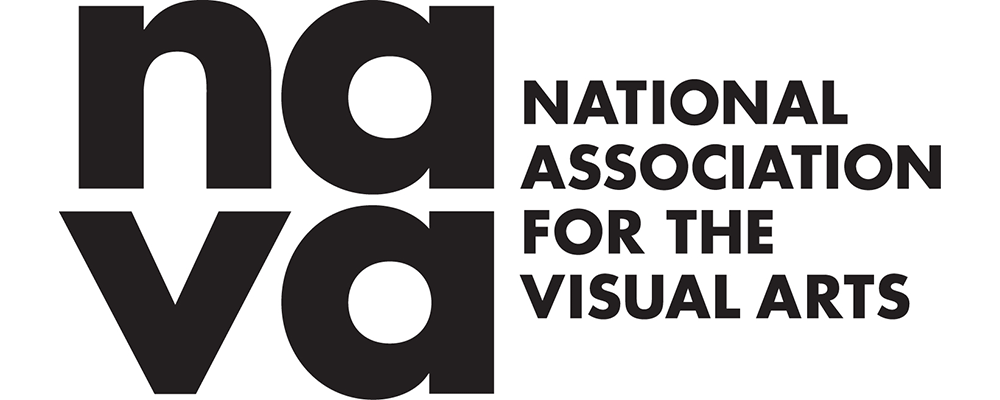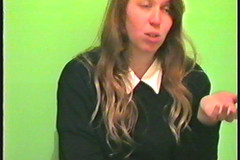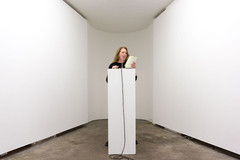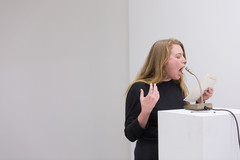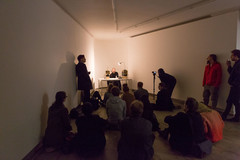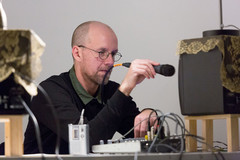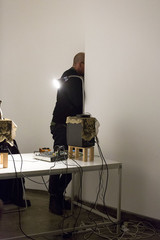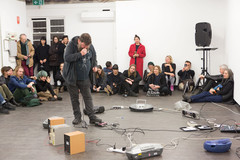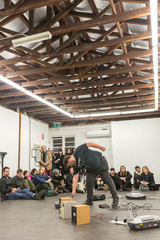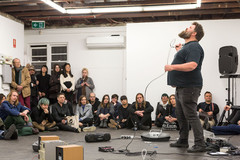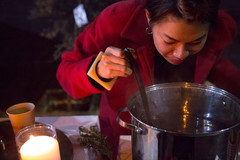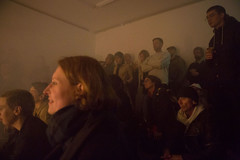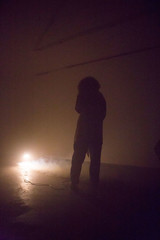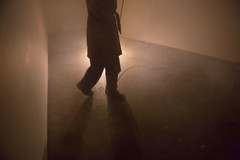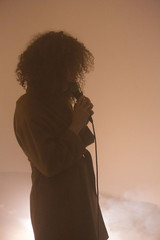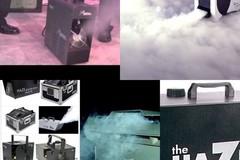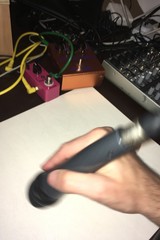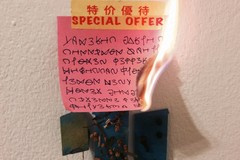Liquid Architecture (LA) is Australia’s leading organisation for artists working with sound and listening. LA is based on Wurundjeri Woi Wurrung Country, at the Collingwood Yards art precinct. Our program sits at the intersection of contemporary art and experimental music, expressed through a range of presentation, publishing, research and commissioning activities.
BACKGROUND
Born in the complex artistic climate of the late 1990s, LA is a millennial imagination of Australia’s vibrant experimental sound culture. Founded in 1999, over the following 15 years, under the direction of Nat Bates, LA grew from being a boutique local event into Australia’s leading festival of experimental, electronic, improvised and avant-garde music.
In 2014, the organisation pivoted with an injection of ideas and resources, and the appointment of Joel Stern and Danni Zuvela as the organisation’s artistic leadership. The duo dissolved the festival model in favour of something more open, unpredictable and experimental: a year-round, curatorial program of boundary-pushing public events, happenings and situations untethered to any one discipline, ideology or format.
Forever expanding and evolving to meet our horizons, the cultural institution we know today as Liquid Architecture is fuelled by the ideas and energies of our team and augmented by the expertise of our board and advisors.
Under the leadership of Kristi Monfries alongside Creative Producer Rohan Rebeiro, Creative Producer James Howard and Programs Coordinator Ronen Jafari, the new direction will expand on this legacy to build strong foundations and relationships with sound experimentations from First Nations, Diasporas, Asia and the Pacific.
Grounded locally but working globally, LA is a dedicated platform for artists engaged in experimental sound practice, sustained and energised through conversation and research, and realised in collaboration with people in our community and beyond.
We acknowledge the Wurundjeri Woi Wurrung as the Traditional Owners and sovereign custodians of the Country on which we practice. We extend our respects to their Elders past and present, and to all First Peoples.
Team
BOARD
DANNY BUTT (CHAIR) is Senior Lecturer in Interdisciplinary Practice at Victorian College of the Arts, University of Melbourne, where he is also Coordinator of Research for Design and Production. His book Artistic Research in the Future Academy was published by Intellect/University of Chicago Press in 2017, and he is on the Editorial Board of the Journal for Artistic Research and is co-convenor of the Asia Pacific Artistic Research Network. As a Certified Management Consultant (CMC) he worked for intergovernmental agencies such as United Nations Development Programme and ASEAN on new media and development and was editor of the book Internet Governance: Asia Pacific Perspectives (Elsevier/UNDP 2006). He works with the Auckland-based art collective Local Time. He moved from Gadigal country in Sydney to Port Chalmers / Koputai, Aotearoa New Zealand in 1993, performing improvised sound and releasing recordings through the 1990s with Peter Stapleton and Kim Pieters in the groups Rain and Flies Inside the Sun (with Brian Crook); with Michael Morley in the Tanaka-Nixon Meeting; and as Cobweb Iris.
REBECA SACCHERO (DEPUTY-CHAIR)
Rebeca Sacchero is a Producer with extensive experience across multiple Metro Melbourne Inner North Local Government Areas. Rebeca understands the local government context whilst also having relationships and experience in small to medium arts orgs. She has been working in the space of community engaged practice and is passionate about creating arts access for under-represented communities. She has a strong track record of successful projects with youth, the LGBTQIA+ community, CALD communities and seniors. She has worked across visual arts, performing arts and digital media, with a range of government and private stakeholders. These include major festivals, local and state Government, ARI’s, schools, community health orgs, and social enterprises. She completed a degree in Art History and Curatorship at Monash University in 2017 and in 2019 was selected for Leadership Victoria’s LGBTQIA+ Leadership program. She also runs her own community building electronic music events in which she has toured international artists, and is a DJ.
MARK NOLEN (TREASURER) is a Certified Practising Accountant with extensive experience in the creative industries sector. He is currently Management Accountant at ACMI, having previously worked in a similar role at Film Victoria. Along the way, he has helped countless singers, actors, and even clowns get their taxes in order – no laughing matter! When not crunching numbers, you can find Mark sitting back with a fine drop of Scotch whisky, soaking up some even finer tunes.
CLAIRE BREDENOORD (SECRETARY) is an education designer and creative producer with experience in non-profit arts organisations, higher education and start-ups. She has a background in socially engaged arts practice and publishing, most often working across disciplines to produce multimodal projects. Most recently, Claire has contributed to the launch of Industri Education, a live music education organisation aiming to provide pathways into industry, as the Operations and Education Lead. A notable achievement has been collaborating with live music industry stakeholders to design new courses in technical production. Claire holds a Juris Doctor and a Master of Arts and Community Practice. She aims to continue developing her diverse skill set and passion for relational community practice to contribute to First Nations peoples’ fight for justice.
MONICA LIM (MEMBER) is a Melbourne-based pianist and composer of classical contemporary and experimental music. Born in Malaysia and then migrating to Australia in her teens, Monica initially practiced as a Tax Consultant for Deloitte Touche Tohmatsu, before pursuing her own interests in business and the arts. She has produced work for theatre, contemporary dance, installations, and film, as well as solo and ensemble instrumental pieces. She is interested in new cross-disciplinary genres and forms as well as combinations of new technology with music. Monica is currently undertaking a PhD at the Faculty of Fine Arts and Music, University of Melbourne in interactive technology, AI and gesture-led composition. Monica is co-founder of Project Eleven, a philanthropic initiative which supports the contemporary arts and serves on the boards of the Melbourne Recital Centre, the Substation as well as the Member’s Council for Musica Viva.
NARETHA WILLIAMS (MEMBER) is an accomplished practitioner in the Australian creative industries sector. An established artist and music producer, she is a seasoned industry professional with extensive experience across a dynamic range of appointments. Naretha has worked with leading Australian companies and First Nations initiatives, flagship festivals and events, has toured internationally and won several awards. Credits include: St Kilda Festival, Bless Your Blak Arts Festival, Australasian World Music Expo, International Symposium on Electronic Art, Yirramboi First Nations Arts Festival, Science Gallery London, Chunky Move, Performance Space New York, The Melba Spiegeltent, Melbourne Town Hall Grand Organ, Sydney Myer Music Bowl, Sydney Dance Company, and Melbourne’s Flash Forward.
GAIL PRIEST (MEMBER) is a sound artist and writer based on Dharug and Gundungurra land (Katoomba, NSW). Her work spans soundtracks for dance, theatre and video, solo electro-acoustic performance as well sound installations for gallery contexts, both solo and in collaboration. She has performed her live compositions and exhibited sound installations nationally and internationally including in Japan, Hong Kong, Germany, France, Norway and the Netherlands. In 2015-16 she was awarded an Emerging & Experimental Arts Fellowship from the Australia Council. She has undertaken numerous radio commissions and releases music on her own label Metal Bitch Recordings as well as Flaming Pines, Endgame Records and room40. She curates events and exhibitions and writes fictively and factually about sound and media art, working for RealTime magazine for over 15 years. She has been on the board of Performance Space (2011-2014), and a peer assessor for the Australia Council. She has just completed a PhD in creative sound theory at UTS. www.gailpriest.net
DAVID CHESWORTH (MEMBER) is an artist and composer, known for his experimental, and at times minimalist music, who has worked with electronics, contemporary ensembles, film, theatre, and experimental opera. Together with Sonia Leber, David has created installation artworks using sound, video, architecture and public participation. Exhibitions include ‘56th Venice Biennale (2015), ‘19th Biennale of Sydney (2014), and Melbourne Now, National Gallery of Victoria, Melbourne (2013-14). Festivals featuring Chesworth’s music and sound works include Ars Electronica; Festival D’Automne de Paris; Bang on a Can Marathon, New York, Biennale of Sydney; Adelaide and Melbourne Festivals; and MONA FOMA. Early in his career he was co-founder of post-punk band Essendon Airport and for five years was coordinator of the Clifton Hill Community Music Centre, Melbourne. David is a Vice-Chancellor’s Postdoctoral Fellow at RMIT University, Melbourne, researching auditory archives.
STAFF
Kristi Monfries (CEO + Director)
Rohan Rebeiro (Senior Creative Producer)
Ronen Jafari (Programs Manager)
James Howard (Creative Producer: First Nations Programming)
Bianca Winataputri (Editor - Disclaimer)
LA ASSOCIATES
Laura McLean and Suvani Suri (Associate Curators - Capture All)
Helen Grogan (Associate Advisor - Liquid Archive)
INTERNS
Maresca Hidayat
Olivia Stephen
Jess Phillips
Contact
We welcome conversation, ideas and feedback at any time.
info@liquidarchitecture.org.au
TW, FB, IG, YT, MX, SC
Journal, Podcast
104/35 Johnston Street
Collingwood VIC 3066
AUSTRALIA
LIQUID ARCHITECTURE
SOUND INC
ABN 73128090237
ASN A0050679K
Privacy Statement
Liquid Architecture (LA) is committed to protecting the privacy and security of personal information obtained and stored about its audience or clientele, including users of this website.
We understand and appreciate that our audience or clientele and users of this website are concerned about their privacy and the confidentiality and security of any information that may be provided to us.
This policy applies when Liquid Architecture determines what information will be collected or disclosed, or how any information will be processed.
We take a broad understanding of what constitutes ‘personal information’. We understand ‘personal information’ to include any information relating to an identified or identifiable natural person. An identifiable natural person is one who can be identified, directly or indirectly, in particular by reference to an identifier such as a name, an identification number, location data, an online identifier or to one or more factors specific to the physical, physiological, genetic, mental, economic, cultural or social identity of that natural person.
Liquid Architecture is bound by the Australian Privacy Principles contained in the Commonwealth Privacy Act and is compliant with the Privacy Amendment (Enhancing Privacy Protection) Act 2012.
We may, from time to time, review and update this Privacy Policy to take account of new laws and technology, changes to Liquid Architecture’s operations and practices and to make sure it remains appropriate to the changing legal environment.
THE TYPES OF PERSONAL INFORMATION LA COLLECTS
The type of information Liquid Architecture collects and holds includes (but is not limited to) personal information, including sensitive information, about:
- Contact information including email address, phone number, names, gender, organisation, role.
- Connection information including linkages and referrals between people.
- Financial information including amounts paid to LA, donated to LA, or received by LA.
- When you visit our website, our server maintains an access log that includes the following information: the visitor’s IP address, the date and time of the visit to the site, the pages accessed and documents downloaded, the previous site visited, and the type of browser used.
- When you visit our website, cookies are stored on your device that provides information to Google Analytics to give us statistical information about our visitors.
HOW PERSONAL INFORMATION IS COLLECTED
LA collects personal information in a variety of different ways depending on the type of contact that is made with the organisation. We collect personal information both from individuals directly and from third parties.
- Subscribing to LA’s newsletter via the website, in-person or other means
- Visiting LA’s website
- Registering for LA’s programs of events (eg. performances, workshops, lectures)
- Purchasing a ticket for LA’s programs of events via a ticketing system
- Making an online enquiry
- Making an individual donation to LA
- Becoming a sponsor
- Submitting a proposal to LA
- Providing written feedback to LA
- Through agreements with programming partners to add addresses to our mailing lists
- Images of persons might be collected during documentation of an LA performance
- If you become a LA Associate, Volunteer or Board Member
LA may also collect personal information over the phone, in person or by electronic correspondence in order to undertake its regular administrative operations
WHY PERSONAL INFORMATION IS COLLECTED
LA collects personal information in order to service the needs of its staff, audience and partnerships. This information is only used with your consent. Your personal information may be retained and used for the following purposes:
- To communicate with staff, artists, associates, volunteers, or Board Members
- For communicating about upcoming programs and services offered by LA and its partners
- For documenting LA performances and events
- To communicate to LA audiences on behalf of other arts or government organisations offering information regarding their products
- For artistic program research and organisational continuous improvement purposes
All details are kept secure at all times and any individual may request their information is not used for direct marketing, research or any other purpose.
DISCLOSURE OF PERSONAL INFORMATION
LA will not sell, lend, disclose, or give personal information of its audience or clientele to external individuals or organisations without first obtaining the customer’s consent.
LA may, however, disclose your personal information or financial data (information exchanged in transactions relating to donations, ticket purchasing or any other product sold):
- To our insurer or legal advisors for the purpose of obtaining insurance coverage, obtaining professional advice, and managing risks.
- To our payment services providers or financial institutions. LA will share transaction data only to the extent necessary for processing, refunding, or dealing with queries about payments.
- In a situation where such disclosure is necessary for compliance with a legal obligation that LA is subject to, or in order to protect the vital interests of a person.
LA will not disclosure personal information to recipients in another jurisdiction unless that jurisdiction has a privacy regime at least as equally protective as Australia. LA will always ask for specific consent before disclosing personal information to a recipient in another jurisdiction.
PERSONAL INFORMATION ACCURACY
LA is committed to ensuring all personal information it collects is accurate, complete and up-to-date. However, the accuracy of this personal information to a large extent depends on the information provided by its clients. LA asks that all clients:
- Advise us if you become aware of any errors in your personal information.
- Advise of any changes in their personal details, such as address, email address and phone number.
YOUR RIGHTS
At any time, any person has the right:
- To know what personal information LA holds about them and how it has been used
- To correct or alter any personal information LA holds about them
- To have the personal information about them erased
- To withdraw consent for the collection, retention, disclosure, use or processing of personal information
- To make a request or inquiry, write to info@liquidarchitecture.org.au
WEBSITE
The LA website contains links to other sites. LA is not responsible for the privacy practices of other sites. LA encourages users when they leave the site to read the privacy statements of each and every web site that collects personal information. This privacy statement applies solely to the activities of LA.
GENERAL DATA PROTECTION REGULATION (GDPR)
LA operates occasional European artistic programming and partnerships, and complies with the data protection policies required by the European Union General Data Protection Regulation (the GDPR) since 25 May 2018.
OUR DATA SECURITY POLICY
LA takes steps to prevent the personal information it holds from misuse, loss, interference or unauthorised access.
LA will also destroy or de-identify personal information when it is no longer needed, or when requested.
ENQUIRIES
If you would like further information about the way Liquid Architecture manages the personal information it holds, please contact LA via info@liquidarchitecture.org.au.
Feedback & Complaints
Liquid Architecture (LA) is committed to respecting feedback and complaints and continually improving our processes. This policy is intended to ensure that we handle complaints fairly, efficiently and effectively. We encourage feedback as part of improving our audience experience and artistic programming.
You can provide feedback or make a complaint via email via email to info@liquidarchitecture.org.au.
HOW DOES LA HANDLE FEEDBACK AND COMPLAINTS?
Upon receiving feedback or a complaint, LA will acknowledge receipt of the feedback or complaint; and request further information if necessary and advise how the issue is likely to be resolved.
LA will not respond to feedback or complaints that violate State or Federal laws, or suggest that others do so; contain profane, violent, abusive, sexually explicit language or hate speech; or are bullying, harassing or disruptive in nature.
Where possible, complaints will be resolved at first contact with us. When appropriate we may offer an explanation or apology to the person making the complaint. Where this is not possible, we may decide to escalate the complaint to LA’s CEOs or Board. Where a person making a complaint is dissatisfied with the outcome of our review of their complaint, they may seek an external review of our decision.
We will take all reasonable steps to ensure that people making complaints are not adversely affected because a complaint has been made by them or on their behalf.
All complaints are confidential. We accept anonymous complaints if there is a compelling reason to do so and will carry out a confidential investigation of the issues raised where there is enough information provided.
HOW LONG WILL IT TAKE FOR MY COMPLAINT TO BE RESOLVED?
The time it takes to resolve a matter depends on the issues raised and any enquiries that need to be made. As a guide, LA aims to acknowledge written feedback and complaints within 1 business day of receipt (if an email address or phone number is provided); respond to all written feedback and complaints within 5 business days of receipt.
LA will consider the matter closed if you indicate that you are satisfied with the response, or LA does not hear from you within 10 business days after sending you its response.
WHAT IF I’M NOT HAPPY WITH THE RESPONSE?
If you are dissatisfied with LA’s response you are encouraged to contact LA to request an internal review. You should outline in writing why you are dissatisfied with the response; and the outcome you are seeking. LA will provide a further response within 10 business days of receiving this information.
If you are dissatisfied with the outcome of our review of their complaint, you may seek an external review of our decision (by the Australian Charities and Not-for-Profits Commission for example).
Australian Charities and
Not-for-Profits Commission
Advice team: 13 22 62
Online Form
TICKET REFUNDS AND EXCHANGES
LA may provide an exchange or refund of a ticket if problems arise before, during or after an event. LA encourages our audience to try to resolve problems as soon as possible after they arise so that we have the best opportunity to find a solution.
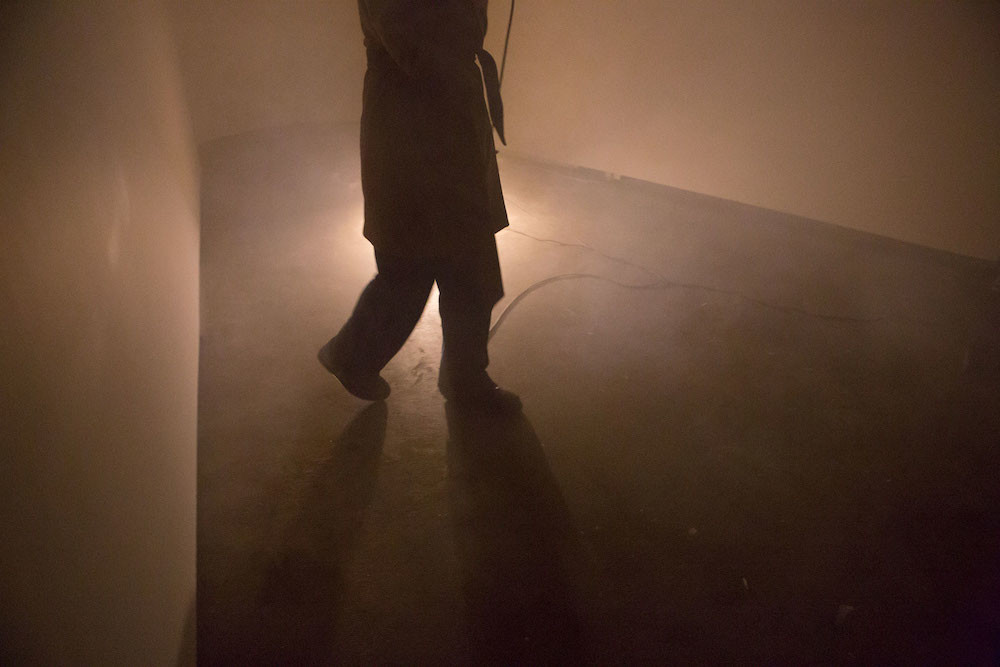
Negative Volumes: Danger Magic
Andrew Harper
Sarah Byrne
Emma Ramsay
Matthew P. Hopkins
Mariam Arcilla
Geoffrey Gartner performs Dick Higgins’ Danger Music
danger magic
There are still magic words. Words of invocation and words of exhortation: words that entice, words that summon, words that compel, words that wound. There are taboo words whose unspeakability must be regularly renewed to ensure it has not decomposed. There are words beyond sense that brim with meaning. There are ways of saying words that can invest them – even the most banal of utterances – with puzzling force. And, there are rituals of bodily complicity right at the level of the sign (try saying “curse” without snarling, or “hex” without hissing).
Before the words, there is the voice (The good voice. The bad voice. Your voice). My voice, issuing from me as it speaks me, doubling back to be heard by me – both me and always beyond me. When we lose the voice and set it upon words, we make a space for listening, between the deed and the intention: a place that’s dangerous, where sound might smuggle itself in.
negative volumes
Negative spaces are never blank. Just as there is no space around objects, only objects in space, there is no gap between sounds, since there is no possibility of silence. Instead what we hear is the noise of the layers, the various shades and feints and foley and interstitial emissions that, stitched together, produce the reassuring throb of frequencies we are schooled to call “background”.
Similarly. A strobe light appears to come on and off, but what we see as light and dark made large, a perfect example of pure black and white, is not in fact discrete. What seems to be simply ‘on’ and ‘off’ is not a dyad. Rather, a strobe is a string, a set, a sequence of pulses giving way to each other: a swelling, an exploding, a fading and then a darkness, until the new swell lights up again. Despite appearances, despite conventional thinking, this is not binary.
In this program, there’s no figure and no ground. There is no negative space. An empty institution is never completely empty. Instead, it becomes a spatial politic for the throwing of light and shade.
In sound, how we structure sonic experience can provide models for how we structure community.
We invite a queering of the spatial politics of the invisible and visible, of the notions of audible and inaudible – a questioning of the question of the one or the other – in order to enter the space opened up by this voluminous negation.
The world is fucked. But, the gallery is empty. What will we do now?
the voices
Andrew Harper
From Hobart, Andrew’s art works with the occult and with money, which he feels are much the same thing.
LA: Do you intend to cast a spell on us?
AH: “Babel (Azathoth) is a live working of found and hoarded elements (cassette recordings and outdated technology) that is hoped to reflect the disquiet and horror of the artist/performer at the temper of the times, and send a sonic ripple back to the makers of this horror: the present government of Australia (such as it is) and the forces further afield.”


Sarah Byrne
Melbourne-based artist Sarah Byrne is interested in the cross-pollination of video, voice and performative practice. Sarah is re-examining the everyday object of the list, to hear how what are meant to be reassuring, organising devices can become threatening, overwhelming or unintelligible when subjected to the deconstructive pressure of the voice.
LA: Are you a crosser or a ticker?
SB: I’m a crosser
I like that strong slashing motion
I prefer crossing something off the list than that little upward flick
I like the cross, it’s a cut, it’s a violence, it’s definitive
I think that’s an aggressive act and that’s why I like it.
Emma Ramsay
Emma Ramsay is a Sydney practitioner whose work considers sound in various engagements with human and other communication. Emma will create a situation for listening to our expectations about different states of matter and luminous low-vis.
LA: How do you you hear smoke and fog?
ER: “In pursuit of a value judgement, perhaps a preference for artificial smoke, haze or fog – both operate differently atmospherically, and yet are interchangeable in theatrical impact. The behaviour of each as vapour is specific, yet the atomisation process is similar for both. Smoke appears during & endures beyond and marks the disaster or burn-off. Metaphors mobilise ‘smoke’, ‘haze’ and ‘fog’ in very specific ways and can wriggle from distinct placement to exchangeable depending on context. If you’re hearing anything, it’s particulate.”


Dick Higgins, Danger Music No. 2, Performance at Fluxus
Internationale Festspiele Neuester Musik,
Wiesbaden 1962.
Geoffrey Gartner
Geoffrey Gartner is a performer, musicologist and long-time devotee of the Fluxus ethos. He will perform a selection of works from the Danger Music series by Fluxus doyenne, Dick Higgins.
LA: What makes Danger Music dangerous and what makes it music?
GG: “Dick Higgins’ forty-three_ Danger Music pieces are part of an anthology of text scores entitled The Danger of Lecturing at Concerts. _Theyappear in his 1969 book, foew&aombwhnw: a grammar of the mind and a phenomenology of love and a science of the arts as seen by a stalker of the wild mushroom. These works date from the early 1960s, a time when Fluxists were challenging the ingrained notion that music had to be a purely sonic experience. They wanted their music to invoke a multi-sensory response and text provided the perfect notational medium.
Always irreverent, Higgins’ sparsely worded scores are frequently ambiguous and open to interpretation – one of the reasons they are so liberating to perform! At the same time, they pose formidable conceptual challenges to performer and audience. In the Danger Music series boundaries are erased; comfort zones obliterated. Danger abounds…”
Matthew P. Hopkins
Sydney-based Matthew P. Hopkins is an artist and musician.
LA: How do you throw the voice?
MPH: “A prepared collage of processed empty cassette tape recordings is improvised upon using a microphone with ring modulator effect. An improvised phrase is developed in real-time via mumbling and murmuring, via the bringing forth of internal mental babble and shaping it into words that ‘make sense’ somehow.
As this phrase takes shape and forms into something that resonates as ‘right,’ two other actions begin: firstly, using the microphone the phrase is traced in the air in front of the speakers so as to cause feedback sounds; and secondly, the phrase is inscribed on a piece of paper using the microphone as writing instrument. The voice, air tracing and inscribing repeat at intervals throughout the performance along with the constant sound of the tape collage. All these sounds are processed live in real-time. This acts as a kind of electronic writing, or electronic inscription via the three different modes of inscribing.
The work is less about automatic writing in the traditional mediumistic/esoteric sense, and is more an act of auto-ventriloquy in the sense that I am attempting to engage directly with inner voice and let it come out. This inner speech is not talking through me so much as it is talking with me.”


Mariam Arcilla
Formerly from the Gold Coast and now based in Sydney, Mariam Arcilla is a writer and producer with a fever for multi-sensorial affairs. She will be concocting an alchemic tonic that responds to the aftertaste of vowels, voids, and volumes.
LA: How do you make turmeric scream?
MA: It comes down to water fluency and temperature. For tea, boil the rhizomatic stem in a pot with ginger, cinnamon and lemon, and you get this yodeling whale call. Mingle turmeric powder with peppermint oil, coconut oil and baking soda for a frictioned toothpaste that hisses and fizzes. To exfoliate the face, mash turmeric powder, chickpea flour, honey and milk; form it into a voluminous, goopy cake that will ‘glow’ the skin but stain everything else it touches (as a result, it’s the person who will scream). Messy thing, this turmeric business.
Partners

Andrew Harper
Babel (Azathoth) is a live working of found and hoarded elements (cassette recordings and outdated technology) that is hoped to reflect the disquiet and horror of the artist/performer at the temper of the times, and send a sonic ripple back to the makers of this horror: the present government of Australia (such as it is) and the forces further afield.
Emma Ramsay
various engagements with human and other communication
Geoffrey Gartner
‘Scream! Scream! Scream! Scream! Scream! Scream!’





